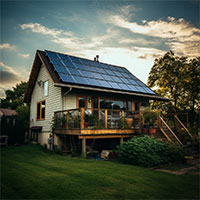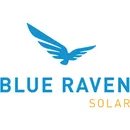Cost of solar panels in Indiana
How much is it to go solar in 2023?

The average cost to install solar panels is $25,460 in Indiana before the federal solar investment tax credit (ITC). The price drops to $17,822 after the ITC.
Going solar in the Hoosier State is about 6% more expensive than the national average. The out-of-pocket investment might be higher than in other states, but you can save by taking advantage of state and federal incentives.
Key insights
- The average cost per watt is $2.68 in Indiana.
- The average payback period in Indiana is 12 years if you pay for your system upfront.
- Indiana residents who go solar save an estimated $21,994 over 25 years.
How much do solar panels cost in Indiana?
Installing residential solar panels can cost between $10,000 and $30,000 or more, with individual costs varying. Your system's size is a big factor in how much you pay overall. Not surprisingly, the smaller your system, the less you pay. The average size of a solar system in Indiana is 9.5 kilowatts (kW).
Not sure what size system you need? You can quickly figure it out with a little math. First, find out the amount of electricity you used in the last year in kilowatt-hours (kWh). You can find this information through your electric account dashboard online.
Then, divide your annual kWh by 1,200 to find the necessary system size. For example, the typical Indiana household uses 11,352 kWh per year. Under this formula, the typical household would need a 9.5-kW system.
» WATT’S THE DIFFERENCE? kW vs. kWh
Average cost by system size in Indiana
| 7 kW | 8 kW | 9 kW | 10 kW | 11 kW | 12 kW | |
|---|---|---|---|---|---|---|
| Before federal tax credit | $18,760 | $21,440 | $24,120 | $26,800 | $29,480 | $32,160 |
| After federal tax credit | $13,132 | $15,008 | $16,884 | $18,760 | $20,636 | $22,512 |
Are solar panels worth it in Indiana?
Solar isn’t as popular in Indiana as in some other states. This might have something to do with the state’s lack of net metering, which compensates you for extra energy you produce and send back to the grid. Still, with the ever-increasing cost of energy, some find that solar panels are worth it.
One solar customer we talked to, Jerry in Indianapolis, admitted he was “a bit skeptical” about making the switch. “It looks cool on the house but having it installed in the winter months — I had my doubts,” he said. Since Jerry went solar, he pays less than $20 per month.
Others highlight the energy independence that comes with getting solar panels plus a battery. For example, Gary in Danville said he went solar because he wanted “emergency backup for a potential future problem.”
And it’s working. “My emergency backup system has a relay box that allows me to pick 10 circuits in my house that are necessary for me to get through an emergency power outage for multiple days, and it's charged by solar,” Gary told us. “Those 10 circuits are off of the grid, and they're reducing my electric bill by 6 or 7 kilowatts a day, which isn't a great amount, but that wasn't the purpose of my installation.”
Indiana residents unhappy with their decision to go solar often tell us about bad equipment or customer service. Like with any big purchase, you have to choose a good company. Otherwise, the investment might not be worth it.
Hoosiers can typically cut their monthly bills with a quality solar array. However, savings go further if you already have an energy-efficient home. Take advantage of AES Indiana’s free virtual energy assessment to see how to reduce your energy usage before going solar.
» STILL NOT SURE? Solar energy pros and cons
Cost factors of going solar in Indiana
Before you jump into going solar, it's important to understand the various cost factors that come into play. The cost of your solar panel system isn't just about the panels themselves. It combines equipment costs, panel efficiency, system size, labor costs and more. Let's dive into some of these factors to give you a clearer picture.
Solar equipment costs
The first thing that probably comes to mind when you think of going solar is the panels, but there are also inverters, batteries and mounting hardware to consider.
High-quality equipment costs more upfront but offers better performance and longevity. Here are some equipment costs you may come across:
- Solar batteries: $7,000 to $18,000
- Monitoring system: $80 to $400
- Solar inverters: $1,000 to $3,000
Solar panel efficiency
When shopping for solar panels, it's worth comparing the efficiency rates of different models. Some of the most efficient panels can convert more than 20% of the sunlight they capture into electricity. Premium panels with higher efficiency rates cost more, but they could save you money in the long run by maximizing energy production.
» COMPARE: Most efficient solar panels
Condition of your roof
Good solar panels are built to last 25 to 30 years, so your roof should have a similar life span. If your roof needs repairs or a total replacement soon, keep in mind that you'll also have to budget for taking down the panels and putting them back up.
For example, Sabine in Merrillville bought solar panels in 2019. There was a roof leak soon after.
“It was a long tedious process but we hung in there,” Sabine told us. “Finally the roof was repaired and it took about 7 weeks to get the panels re-installed. That means there was NO power generation during peak months, and we had to pay electric bills.”
» SHOULD YOU: Replace your roof before going solar?
How you pay
There are several ways to pay for your solar panel system. You can pay upfront, take out a solar loan or lease the system. Leasing can include little to no down payment but may come with other fees and less financial benefit in the long run.
Labor and installation costs
Installation is another significant cost factor. Labor costs can vary depending on the complexity of the installation and the company you choose. Always get multiple quotes and read reviews to ensure you're getting the best deal. Also, look for companies with proper certifications and experience in the field.
» GUIDE: Solar panel installation
Other solar cost factors
Don't forget about the local permits and fees required for solar panel installation. These can vary by location and add to your system's overall cost.
Also, solar panels require minimal maintenance, but you should consider the lifetime cost. This includes potential repairs or replacement of components, periodic cleaning and system monitoring. These costs are generally low but shouldn’t be overlooked.
Solar incentives, tax credits and rebates in Indiana
The average cost to install a solar panel system after tax credits in Indiana is $17,822.
The federal solar investment tax credit (ITC) is the best way to reduce the cost of going solar in Indiana. If you install a residential solar panel system by the end of 2032, you can get a federal income tax credit equal to 30% of the system's total cost — including equipment, labor and permits. The credit drops to 26% in 2033 and 22% in 2034. The average ITC value in Indiana is $7,638 in 2023.
Indiana also offers a partial property tax exemption for residents using solar. The amount varies based on the overall cost of your system.
» EXPLORE: Indiana solar incentives
Compare solar installation companies in Indiana
Compare popular solar companies available in Indiana below. Read our guide to finding the best solar companies for more.
» TIPS: How to get the best solar quotes
| SunPower | Blue Raven Solar | ShopSolar | Green Home Systems | ||||
|---|---|---|---|---|---|---|---|
| Primary | SunPower | Read reviews | Customer Ratings 4.3 | Free consultation | Payment options
Cash, loan, lease
| Warranty
10 to 25 years
| |
| Primary |  | Blue Raven Solar | Read reviews | Customer Ratings 4.7 | Free consultation | Payment options
Cash, loan
| Warranty
25-year manufacturer warranty, plus a 10-year workmanship warranty
|
| Primary |  | ShopSolar | Read reviews | Customer Ratings 4.7 | Free consultation | Payment options
Cash, loan
| Warranty
Varies
|
| Primary |  | Green Home Systems | Read reviews | Customer Ratings 3.8 | Free consultation | Payment options
Cash, loan
| Warranty
Varies by system
|
FAQ
How are solar costs trending in Indiana?
The cost to go solar in Indiana has fallen 43% over the last 10 years, according to the Solar Energy Industries Association.
Can I get free solar panels in Indiana?
There are no programs for free solar panels in Indiana. You can lease a solar energy system with little to no upfront costs, though.
» FREE SOLAR PANELS: Are they really free?
How much can I save with solar panels?
The average 25-year savings with solar in Indiana is $21,994 if you pay upfront. If you still have a bill after going solar, you’ll typically still pay significantly less than before. You can expect to offset your electricity bill by 66% to 89%, according to EnergySage.
» EXPLORE: Where solar savings go the furthest
How does net metering work in Indiana?
Indiana ended net metering in 2017. People who entered their net metering contracts before December 2017 can keep their contracts until July 1, 2047, and those who signed up before July 1, 2022, can continue net metering until July 1, 2032, according to DSIRE.
How many solar panels do I need for my house?
The number of solar panels you need depends on how much electricity your household uses and the type of panel. In Indiana, the average monthly energy consumption is 946 kWh. On average, a 2,000-square-foot home needs about 19 solar panels.
Bottom line
In Indiana, going solar is a little more expensive than in other states. Still, you can save a lot of money with the federal solar ITC and the property tax exemption. The average Indiana resident who installs solar panels saves $21,994 over 25 years.
Solar costs: Indiana vs. nearby states
| Upfront cost* | ITC value (30%) | Typical system size | Average cost per watt | Payback period** | Estimated net savings | |
|---|---|---|---|---|---|---|
| Indiana | $25,460 | $7,638 | 9.5 kW | $2.68 | 12 years | $21,994 |
| Illinois | $20,476 | $6,143 | 7.5 kW | $2.73 | 12 years | $16,585 |
| Ohio | $23,040 | $6,912 | 9.5 kW | $2.56 | 12 years | $19,272 |
| Kentucky | $25,740 | $7,722 | 11 kW | $2.34 | 12 years | $20,247 |
| Michigan | $19,670 | $5,901 | 7 kW | $2.81 | 10 years | $23,652 |
Article sources
- EcoWatch, “ How Much Do Solar Panels Cost in Indiana? .” Accessed Oct. 12, 2023.
- Office of Energy Efficiency & Renewable Energy, “ Homeowner’s Guide to the Federal Tax Credit for Solar Photovoltaics .” Accessed Oct. 12, 2023.
- Solar Energy Industries Association, “ Indiana Solar .” Accessed Oct. 12, 2023.
- DSIRE, “ Indiana Solar Programs .” Accessed Oct. 12, 2023.
- DSIRE, “ Indiana Net Metering .” Accessed Oct. 31, 2023.
- Indiana Office of Energy Development, “ Fuel Facts: Solar Energy .” Accessed Oct. 12, 2023.
You’re signed up
We’ll start sending you the news you need delivered straight to you. We value your privacy. Unsubscribe easily.
